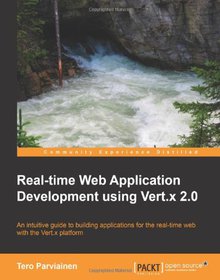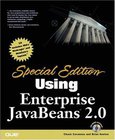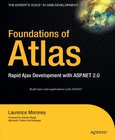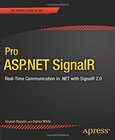Real-time Web Application Development using Vert.x 2.0

Book Details:
| Publisher: | Packt Publishing |
| Series: | Packt , Using |
| Author: | Tero Parviainen |
| Edition: | 1 |
| ISBN-10: | 1782167951 |
| ISBN-13: | 9781782167952 |
| Pages: | 122 |
| Published: | Sep 24 2013 |
| Posted: | Nov 19 2014 |
| Language: | English |
| Book format: | |
| Book size: | 7.75 MB |
Book Description:
An intuitive guide to building applications for the real-time web with the Vert.x platform Overview Get started with developing applications for the real-time web From concept to deployment, learn the full development workflow of a real-time web application Utilize the Java skills you already have while stepping up to the next level Learn all the major building blocks of the Vert.x platform Follow a hands-on tutorial with a running example In Detail Vert.x is a platform for building highly networked and scalable applications on the Java Virtual Machine. Using just a few powerful building blocks, it provides a powerful framework that scales to a multitude of different usage scenarios. It is one of the few truly polyglot development platforms, providing seamless interoperability between components written in JavaScript, CoffeeScript, Java, Ruby, Python, and Groovy. Real-time Web Application Development with Vert.x will show you how to get up and running on the powerful Vert.x platform. Using a hands-on example of developing a mind map editor, this book shows you how to build a Vert.x application from the ground up, and on the way introduces all of the major building blocks of Vert.x, such as integrating with a database, polyglot development, and so on. Real-time Web Application Development with Vert.x will guide you step-by-step through building a Vert.x application so that you'll be able to start building one of your own in no time. From initiation to scaling, you'll develop a mind map editor application with real-time collaboration capabilities. As you go through the development process, you'll get to know all the building blocks of Vert.x applications: Verticles, Worker Verticles, the Event Bus, and Modules. You'll also see how Vert.x apps seamlessly reach into client devices by building a client application using the Vert.x Event Bus Bridge, Knockout.js, and D3.js. Real-time Web Application Development with Vert.x guides you through the whole Vert.x application development process, tying all of the important concepts together with a simple, realistic example application. What you will learn from this book Set up a Vert.x development environment with ease Organize application code into nice and tidy components using Verticles Build browser-based clients for Vert.x apps using HTML5 and technologies like Knockout.js and D3.js Integrate your Vert.x app with MongoDB to make your data persistent Use the Vert.x Event Bus to add real-time collaboration features to your app Seamlessly integrate components written in different programming languages so that you can use whatever language is the best fit for each problem Organize your code into modules and distribute Vert.x libraries to your organization or to the open source community Integrate Java libraries into your Vert.x application and tap into the vast Java library ecosystem Scale your Vert.x application by tuning the deployment configuration of your Verticles Approach A quick, clear, and concise tutorial-guide-based approach that helps you to develop a web application based on Vert.x. Who this book is written for Real-time Web Application Development with Vert.x is written for web developers who want to take the next step and dive into real-time web application development.This book uses JavaScript (and some Java) to introduce the Vert.x platform, so basic JavaScript knowledge is expected. If you're planning to write your applications using some of the other Vert.x languages, all the techniques and concepts will translate to them directly. All you need to do is refer to the Vert.x API reference documentation to see the particular APIs for your language.
Download Link:
Related Books:
Using Enterprise JavaBeans 2.0
Special Edition
Special Edition Using EJB 2.0 starts with a description of how EJB fits into the big picture of J2EE development, then covers such topics as: Locating EJB's using JNDI Managing data with EJB Query Language Building JMS applications using the new Message-driven Bean Planning EJB applications using design patterns Later chapters describe advanced development topics including interoperability, horizontal services and clustering. Throughout the book, the authors construct a component-based auction web site using the J2EE architecture as a practical example....
Foundations of Atlas
Rapid Ajax Development with ASP.NET 2.0
This book introduces a fast-track path to understanding Atlas, and how this technology can increase the power and functionality of your code while conserving time and effort. The book begins with a bare-bones introduction that explains how Atlas relates to Ajax. Microsoft Atlas is a web-client framework that makes building Ajax-style applications easier. It provides a prewritten framework that gives you a structured environment in which to work. Atlas also provides you with an object model and standardized debugging to make development faster and simpler. Ajax is a way of combining a number of Web technologies including JavaScript, dynamic HTML, and a feature known as XMLHttp (which reduces the need for client browsers to constantly reconnect to the ...
Pro ASP.NET SignalR
Real-Time Communication in .NET with SignalR 2.0
ASP.NET SignalR is the new solution to real-time communication between servers and clients in .NET. Use it to push new data to a web page or mobile device as soon as it becomes available, whether it's a notification, live chat, up-to-the-minute financial data, or a range of other exciting applications. Innovations like Google live search and live Facebook and Twitter updates are pushing users' expectations of the real-time web. With Pro ASP.NET SignalR, you can join this revolution and learn skills that will be valuable for years to come.Pro ASP.NET SignalR starts with an introduction to the real-time web. Learn about the technologies underlying the SignalR library, such as WebSockets and long-polling, and how SignalR elegantly flips between them dep...
2007 - 2021 © eBooks-IT.org



